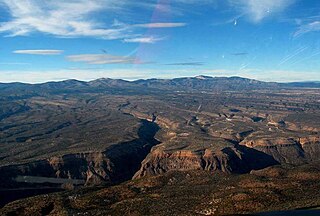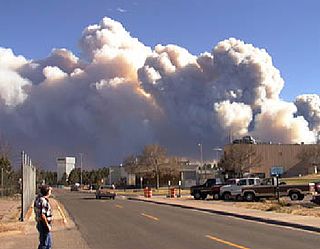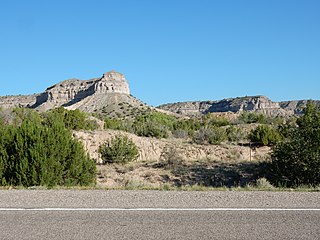
White Rock is an unincorporated community and census-designated place (CDP) in Los Alamos County, New Mexico. It is one of two major population centers in the county; the other is Los Alamos. The population was 5,725 at the 2010 census. It is largely a bedroom community for employees of Los Alamos National Laboratory and their families. Access to White Rock from the town of Los Alamos and other cities and towns in New Mexico is via New Mexico State Road 4, which forms the northwestern boundary of the community. Administratively, White Rock is a neighborhood of Los Alamos; locals refer to Los Alamos as "the Townsite," or "the Hill".

Valles Caldera is a 13.7-mile (22.0 km) wide volcanic caldera in the Jemez Mountains of northern New Mexico. Hot springs, streams, fumaroles, natural gas seeps and volcanic domes dot the caldera floor landscape. The highest point in the caldera is Redondo Peak, an 11,253-foot (3,430 m) resurgent lava dome located entirely within the caldera. Also within the caldera are several grass valleys, or valles, the largest of which is Valle Grande, the only one accessible by a paved road. In 1975, Valles Caldera was designated as a National Natural Landmark by the National Park Service with much of the caldera being within the Valles Caldera National Preserve, a unit of the National Park System.

Chatsworth is a suburban neighborhood in Los Angeles, California, in the San Fernando Valley.

Bandelier National Monument is a 33,677-acre (136 km2) United States National Monument near Los Alamos in Sandoval and Los Alamos counties, New Mexico. The monument preserves the homes and territory of the Ancestral Puebloans of a later era in the Southwest. Most of the pueblo structures date to two eras, dating between AD 1150 and 1600.

Topanga State Park is a California state park located in the Santa Monica Mountains, within Los Angeles County, California. It is part of the Santa Monica Mountains National Recreation Area.

The Pajarito Plateau is a volcanic plateau in north central New Mexico, United States. The plateau, part of the Jemez Mountains, is bounded on the west by the Sierra de los Valles, the range forming the east rim of the Valles Caldera, and on the east by the Puye escarpment, which rises about 300 to 400 feet above the Rio Grande valley about a mile (1.6 km) west of the river. The Rio Grande passes through White Rock Canyon to the southeast, and the Caja del Rio across the river is sometimes regarded as part of the plateau. The plateau is occupied by several notable entities, including Bandelier National Monument, the town of Los Alamos and its remote suburb White Rock, and Los Alamos National Laboratory. Elevations range from about 5,600 feet at the river to about 7,800 feet where the plateau merges into the mountain range.

The Cerro Grande Fire was a prescribed forest fire in Los Alamos, New Mexico, United States of America, that occurred in May of 2000. The fire started as a controlled burn, and became uncontrolled owing to high winds and drought conditions. Over 400 families in the town of Los Alamos, New Mexico, lost their homes in the resulting 43,000-acre (170 km2) fire. Structures at Los Alamos National Laboratory were also destroyed or damaged, although without loss or destruction of any of the special nuclear material housed there. No loss of human life occurred. The US General Accounting Office estimated total damages at $1 billion.

The Dome Fire was a destructive wildfire in the Jemez Mountains in the northern region of the U.S. state of New Mexico during the 1996 fire season. It has been described by forester Bill Armstrong as "a wakeup call that nobody woke up to", anomalous at the time but an indicator of future high-intensity fires that are becoming more common due to both local and global environmental changes.

The La Mesa Fire was a 1977 wildfire on the Pajarito Plateau of New Mexico, in the Southwestern United States.

The Los Alamos Historical Museum is housed in the historic Guest House, located next to Fuller Lodge, of Los Alamos Ranch School, which was General Leslie Groves's favorite place to stay during the Manhattan Project.

New Mexico State Road 502 (NM 502) is a 18.301-mile-long (29.453 km) state highway in New Mexico, United States of America. It is notable as the main access route to Los Alamos National Laboratory (LANL), Bandelier National Monument, Valles Caldera National Preserve, Jemez Mountains, and town of Los Alamos.

Caja del Rio is a dissected plateau, of volcanic origin, which covers approximately 84,000 acres of land in northern Santa Fe County, New Mexico, United States. The region is also known as the Caja, Caja del Rio Plateau, and Cerros del Rio. The center of the area is approximately 15 miles (23 km) west of Santa Fe, New Mexico. Most of the Caja is owned by the United States Forest Service and managed by the Santa Fe National Forest. Access is through New Mexico Highway 599, Santa Fe County Road 62, and Forest Service Road 24.

Los Alamos is a census-designated place in Los Alamos County, New Mexico, United States, that is recognized as one of the development and creation places of the atomic bomb—the primary objective of the Manhattan Project by Los Alamos National Laboratory during World War II. The town is located on four mesas of the Pajarito Plateau, and had a population of about 13,200 as of 2020. It is the county seat and one of two population centers in the county known as census-designated places (CDPs); the other is White Rock.

The Las Conchas Fire was a large wildfire in the state of New Mexico, in the United States, in 2011. The fire started in Santa Fe National Forest and burned more than 150,000 acres, threatening Los Alamos National Laboratory and the town of Los Alamos. After five days of burning, it became the largest wildfire in New Mexico state history at the time. It was surpassed in 2012 by the much larger Whitewater-Baldy Complex Fire and in 2022 by the Calf Canyon/Hermits Peak Fire and the Black Fire making the Las Conchas Fire the fourth-largest fire in New Mexico's recorded history.

The Otowi Suspension Bridge, spanning the Rio Grande River near San Ildefonso, New Mexico, is a wooden single-lane suspension bridge for road traffic, built in 1924. It was listed on the National Register of Historic Places in 1997.
Buckman is a ghost town in Santa Fe County, New Mexico, United States of America, about 5 miles (8.0 km) south of San Ildefonso Pueblo, on the east bank of the Rio Grande in White Rock Canyon.
Dwight Smith Young was an American "carpenter, photographer, archaeologist, cook, meteorologist, poet and self-made physicist" who took part in the Manhattan Project. He was given the nickname "The Hermit of Pajarito Canyon" after making his home in an old log cabin in a remote canyon on the Los Alamos testing site from roughly 1946 to 1952.
Bayo Road, in Los Alamos, New Mexico, was listed on the National Register of Historic Places in 2003. It is also known as Bayo Canyon Road.

The Bandelier Tuff is a geologic formation exposed in and around the Jemez Mountains of northern New Mexico. It has a radiometric age of 1.85 to 1.25 million years, corresponding to the Pleistocene epoch. The tuff was erupted in a series of at least three caldera eruptions in the central Jemez Mountains.

The Puye Formation is a geologic formation exposed east of the Jemez Mountains of northern New Mexico. Radiometric dating constrains its age to between 5 and 2 million years, corresponding to the Pliocene epoch.


















